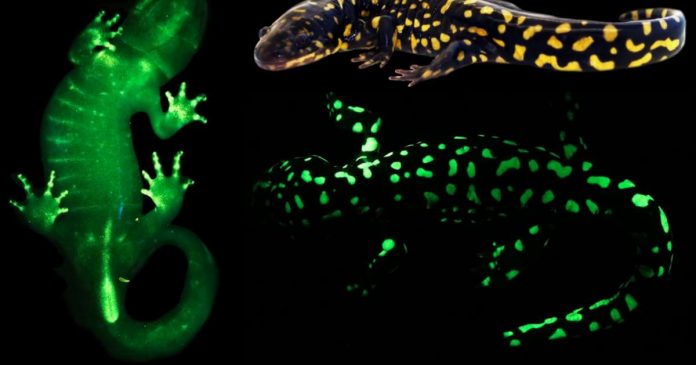You’ve never seen amphibians in this light before. Like, literally, this specific azure light. Today in the journal Scientific Reports, researchers for the first time show that amphibians glow if you throw blue light on them. The tiger salamander suddenly pops with brilliant green spots. Cranwell’s horned frog is striped in a nuclear glow. Even the marbled salamander’s tiny toe bones fluoresce brightly—oh, and as does its cloaca, perhaps as a kind of sexual display.
Don’t bother going to your neighborhood pond with hopes of witnessing this phenomenon under regular old “white light,” or daylight. This kind of biofluorescence only happens when blue light hits the amphibian, whose skin—and bones, in the case of the marbled salamander—absorb that wavelength and emit a different wavelength, usually an electric green. (This is not the same as bioluminescence, in which an animal like a deep-sea anglerfish either produces its own light through chemical processes or with the help of a glowing symbiotic bacteria that lives in its body.) To get these images, the researchers flooded the amphibians with blue light and photographed them with a special filter that only allowed the fluorescent light from the animal to hit the camera.
They looked at 32 amphibian species, and managed to study eight of the 10 families of salamanders. Every single one glows—some intensely, others less so. The tiger salamander in particular throws off gobs of green light. “When we imaged that species, it was really startling to both of us just how bright and brilliant the fluorescence was,” says St. Cloud State University herpetologist Jennifer Lamb, who published the paper with her colleague Matthew Davis, an ichthyologist. (A fish guy studying amphibians? Don’t worry—he studies biofluorescence under the deep blue sea too.) “We also saw fluorescence in animals that otherwise under white light might kind of look like plain Janes, that were maybe a duller brown or gray,” Lamb adds.
Exactly where on its body an animal fluoresces might lend clues to the functional significance of its colors, though Lamb and Davis caution that much of this thinking is still just a hypothesis. Some groups of amphibians produce fluorescent mucus; some glow all over. Salamanders tend to glow brightly on their bellies, but not on their backs, which might help them hide from predators above. Newts are extra interesting, because they often have yellow or orange bellies that are already quite bright in daylight. When they’re threatened, they’ll arch their bodies and show off that tummy, a warning to predators that they might be toxic, a signal known as aposematism. “And we showed that those brightly colored surfaces are also biofluorescent,” says Lamb. “So that lends the question: Potentially could these predators be also able to pick up that biofluorescent signal? In that case might fluorescence serve as a warning?”
For salamanders and caecilians—weird little limbless amphibians that look like worms and eat their mother’s skin—the point of looking extra hot might be, well, reproduction. “Oftentimes there was a concentration of fluorescence associated with the external features of their reproductive organs,” says Davis. “That also could have some sort of potential functional significance.”
By digging deeper into these functions, scientists can begin to unravel the evolutionary history of biofluorescence in amphibians. Given that the researchers found the trait in all of the frog, salamander, and caecilian species they tested, they might assume that fluorescence is highly conserved in their lineage—that is, long ago a common ancestor of all these animals evolved the trait, and it proved so useful that it stuck around as amphibians went their separate ways on the tree of life.





























